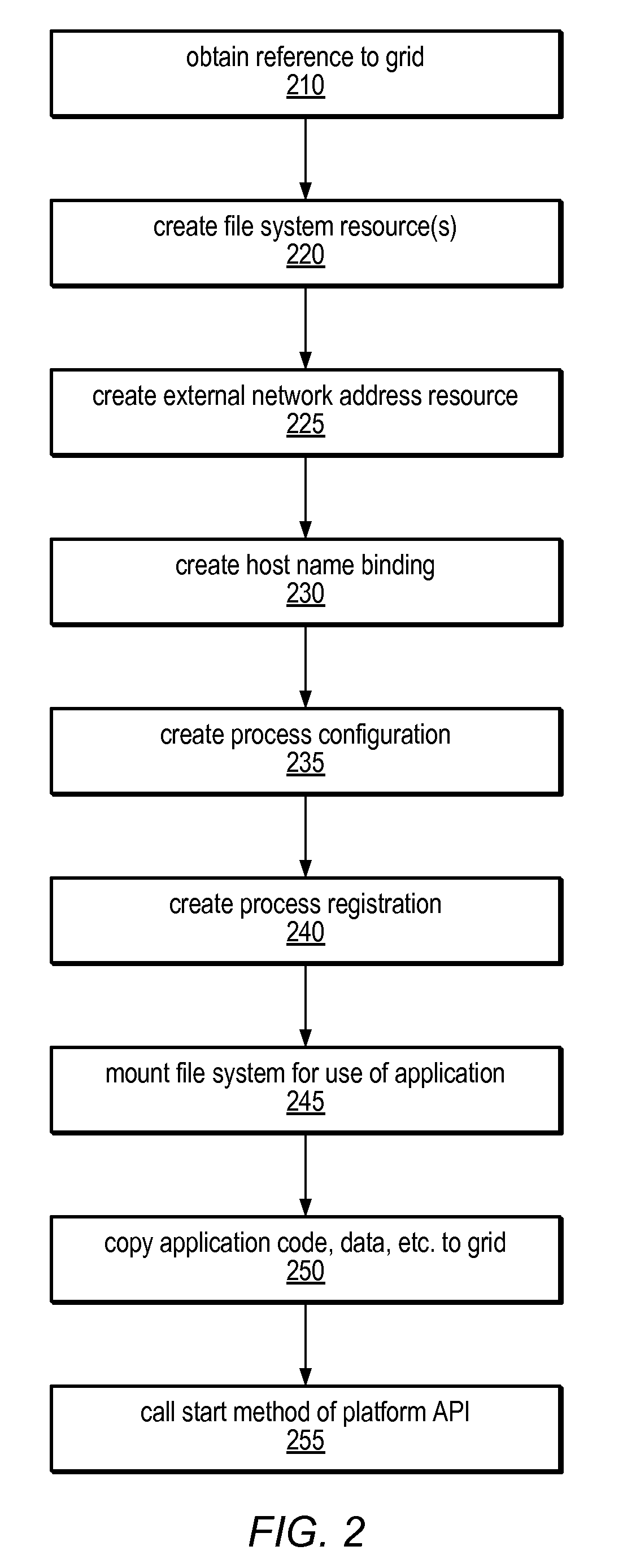[0006]Systems and methods for providing a dynamic virtualized grid of language-level virtual machines (VMs), networks, and storage are disclosed. The systems and methods described herein may in some embodiments operate to host services on behalf of
software-as-a-service (SaaS) providers and / or business-internal applications. The systems and methods described herein may help SaaS providers deal with continuously changing demands on their services by speeding up development and delivery of those services using high-level
programming languages, allowing them to update in-production services frequently. A
system such as described herein may be designed to serve as a commercial hosting platform for both the development and deployment of long-running Internet-based services. In some embodiments, the
system may support the ability to dynamically scale resource usage both up and down to match changing demands by providing SaaS providers the ability to programmatically create and alter their own
system level structures (e.g., their own virtual systems) at runtime, drawing from a horizontally scaled
pool of virtualized compute, storage, and network resources.
[0007]The systems and methods described herein may be implemented as a computing platform that eases the development, deployment, management and monitoring of distributed applications and / or services. This platform may include a programmatic API
usable to manage resources dynamically and without the need to involve a human administrator. The use of such an API may in some embodiments enable programs (e.g., applications that implement a service) to securely manage their own resources in a consistent fashion, including naming, discovery, creation, deletion, modification, and monitoring of those resources, and to deal with failures that occur during any of these operations. In some embodiments, the API may provide a consistent scheme for tracking significant state changes of the managed resources through event delivery. The platform may provide the ability to deal with a collection of distributed resources as a single aggregate system, and also the ability to compose collections of resources towards the construction of larger applications. Furthermore, the platform may be configured to track certain dependencies between resources, enabling a customer application to detect potential inconsistencies that may arise during the manipulation of those resources.
[0008]In some embodiments, platform resources (including language-level virtual machines, networks, and network accessible file systems and databases) are exposed through high-level abstractions. These abstractions may improve developer productivity by providing simplified interfaces to infrastructure resources. They may also enable developers to create robust, long-living services by insulating service code from changes to the underlying infrastructure. The system and methods described herein may in some embodiments present a horizontally scaled
pool of distributed resources as a single system, providing developers with a unified platform for allocating and controlling these resources (e.g., as a dynamically configurable virtual system). In addition to simplifying a developer's use of distributed resources, this
unified system model may also allow the platform to draw on the horizontally scaled
resource pool to meet the allocation requests of
multiple applications, which may be executing on behalf of multiple users.
[0010]A development and deployment platform, as described herein, may in some embodiments support programmatic spawning of VMs in a
distributed computing environment; programmatic allocation of networks, IP addresses, host names, file systems, and
database instances; and programmatic control of
network connectivity between resources (e.g., between VMs, storage, and
the Internet), including
connectivity between resources of different customers. In some embodiments, platform storage resources may include a ZFS
file system (e.g., a Zettabyte
File System in Solaris™), and developers may be able to take
advantage of ZFS features such as snapshots and clones during development and / or deployment of their applications. Internet-facing
connectivity supported by the platform may in various embodiments include static and dynamic
Network Address Translation (NAT), Layer-4 and / or Layer-7 load balancing (including HTTPS), name-based
virtual hosting, and
direct binding to Internet-routable IP addresses for maximum protocol flexibility. The base system API may in some embodiments be layered on
Java™ Platform, Standard Edition (
Java SE).
 Login to View More
Login to View More  Login to View More
Login to View More 


